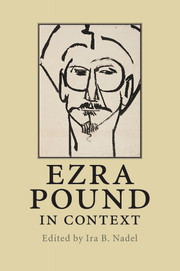Book contents
- Frontmatter
- Contents
- Notes on contributors
- Acknowledgements
- Chronology
- List of abbreviations and note on references to The Cantos
- Introduction
- Part I Biography and works
- Part II Historical and cultural context
- 16 The classics
- 17 Provençal and the troubadours
- 18 Dante and early Italian poetry
- 19 America
- 20 Venice
- 21 London
- 22 Paris
- 23 Rapallo and Rome
- 24 Pisa
- 25 Imagism
- 26 Vorticism
- 27 Music
- 28 Visual arts
- 29 Confucius
- 30 The Orient
- 31 Little magazines
- 32 Publishing and publishers
- 33 Modernism
- 34 Fascism
- 35 Anti-Semitism
- 36 Gender and sexuality
- 37 Race
- 38 Travel
- Part III Critical reception
- Further reading
- Index
32 - Publishing and publishers
Published online by Cambridge University Press: 05 July 2014
- Frontmatter
- Contents
- Notes on contributors
- Acknowledgements
- Chronology
- List of abbreviations and note on references to The Cantos
- Introduction
- Part I Biography and works
- Part II Historical and cultural context
- 16 The classics
- 17 Provençal and the troubadours
- 18 Dante and early Italian poetry
- 19 America
- 20 Venice
- 21 London
- 22 Paris
- 23 Rapallo and Rome
- 24 Pisa
- 25 Imagism
- 26 Vorticism
- 27 Music
- 28 Visual arts
- 29 Confucius
- 30 The Orient
- 31 Little magazines
- 32 Publishing and publishers
- 33 Modernism
- 34 Fascism
- 35 Anti-Semitism
- 36 Gender and sexuality
- 37 Race
- 38 Travel
- Part III Critical reception
- Further reading
- Index
Summary
In the past twenty years, modernist studies has radically revised the conventional wisdom about modernism and its relationship to commerce, capitalism, and mass culture. Rejecting the claim that modernism was a mandarin movement, headed by highbrow reactionaries such as T.S. Eliot and Ezra Pound, the new modernist scholarship points to the many and forgotten links between modernism and mass culture. Certainly, links between the two had always been acknowledged, but they were connections of anathema: high modernist works such as The Cantos, “The Hollow Men,” and even Ulysses were read as execrating mass culture, especially the kind of mass culture produced by capitalism. It followed, then, that modernist writers saw themselves as above the marketplace: to them mass popularity or success in the market was a sign of artistic failure.
But modernist writers such as Pound and Joyce were deeply involved in the marketplace and in the outlets of mass culture and not just to condemn them. This is nowhere clearer than in the relationship of modernist writers to their publishers. Throughout his career Pound published with very small presses as well as with large trade publishers in the USA and Britain, for whom he helped shape marketing and promotion campaigns for his books. Like modernism itself, Pound's publishing history describes an oscillation between coterie and crowd, between highbrow and middlebrow, between private presses and commercial establishments. And in this Pound becomes, perhaps, the signal example of modernism's ambivalence about commercial publishing, of the modernist desire to reach (and convert) a mass audience and its fierce insistence that it was aimed at the few.
- Type
- Chapter
- Information
- Ezra Pound in Context , pp. 356 - 365Publisher: Cambridge University PressPrint publication year: 2010

